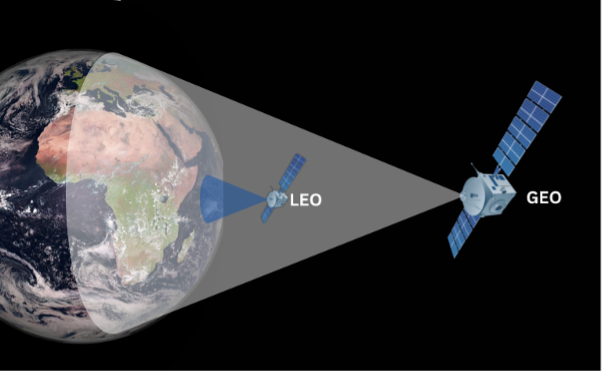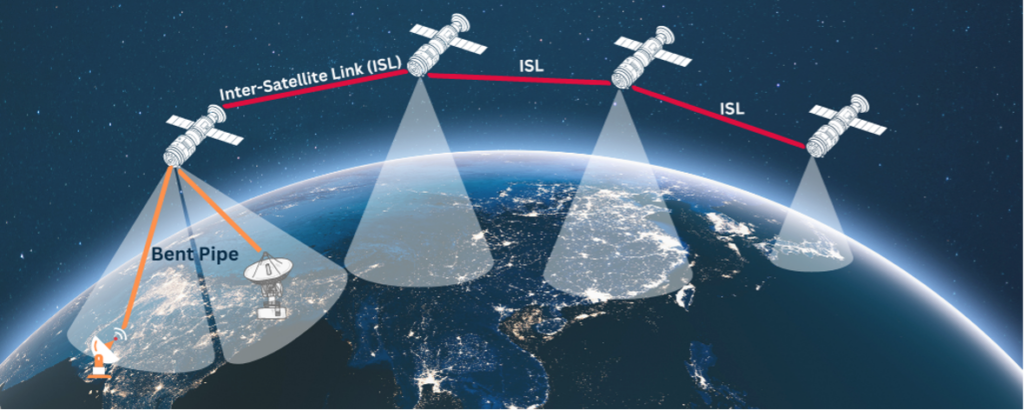
After years of development and almost three years of successful and continuous launches of more than 2,500 satellites, Starlink is gaining a reputation for providing a much-needed viable broadband alternative to remote regions not served by traditional providers.
In this study, my colleagues and I at the University of Surrey and Telefonica Research sought to learn whether Starlink is indeed a compelling alternative to traditional broadband, and what limitations it may have.
We found that Starlink can provide on average over 147Mbs connectivity (in Europe) and 113.7 milliseconds latency (on long links across continents), more than sufficient for today’s normal Internet needs and comparable to both wired and wireless (cellular) mainstream alternatives. However, we concluded that a lack of Inter-Satellite Links (ISLs) is holding it back compared to cellular. Also, there is a significant source of variability such as weather.
Starlink reduces latency by being ‘closer’ to its users
The main difference between Starlink Low-Earth Orbit (LEO) satellites and traditional satellites operating in the geosynchronous (GEO) orbits is the distance of the satellites from terminals on earth: GEO satellites are 35,000km away, whereas LEO satellites are much closer. For example, Starlink has five orbital shells, the closest of which is only 550km away.
Being closer reduces latency, comparable to traditional broadband providers. However, this approach also requires many more satellites, as each satellite is only within sight of a ground station for a short time. This has led to the development of so-called ‘mega constellations’ of satellites (Starlink aims to get 40,000 satellites orbiting the Earth in the next few years). Because there are many more satellites, the overall capacity of the network is also higher, and Starlink promises dramatically higher bandwidths than traditional satellite Internet providers.
Starlink vs cellular vs fibre Internet
To conduct our experiment, we obtained access to a Starlink terminal (commonly known as ‘dishy’) in the same location where we also had access to both fibre and cellular broadband. Using network measurement tools such as traceroute, we measured the network latency for the three Internet connections: Starlink, fibre and cellular.
The Round Trip Time (RTT) is the time the Internet traffic takes to travel from the source to the destination and back. In this study, the source is a university campus in the Greater London area and the destination is a data centre in North Virginia, USA. We found that overall Starlink is around:
- 11% faster than a major mobile operator (Starlink Internet latency was 113.7 milliseconds, and the cellular Internet latency was 127.3 milliseconds)
- 32% slower than a fibre broadband connection (fibre Internet latency was 85.9 milliseconds).
The main reason for Starlink’s latency comes from its ‘Bent Pipe’ architecture — a network design architecture where the Internet traffic travels from the Starlink terminal (consumer’s terminal) to the visible satellite and then back to the Earth through Starlink’s Gateways or Point of Presence (POP) where the Internet traffic continues to the final destination through a conventional fibre network. We believe that connections between geographically distant endpoints (such as Europe and USA) may not see the full benefits of Starlink until ISLs become the norm, offsetting the additional latency of the satellite link with lower delays in crossing the Atlantic via ISLs.
Does the weather affect Starlink’s performance?
Next, we explored the effect of weather, specifically cloud cover, on the performance given the need for a wireless link to a satellite beyond the Earth’s atmosphere.
This time, we asked volunteers who are using Starlink Internet as their only way to access the Internet to install a web browser plugin we developed that collects the latency of different websites during volunteers’ daily web browsing activities. The webpage latency is the time it takes the web browser to request the webpage and get a reply from the web server.
With each webpage latency record we stored in the database we also stored the weather condition at the users’ location using open-source weather tools. Comparing the two sets of data we found a noticeable effect of the weather on the webpage latency performance; specifically median webpage latency is around 470.5 milliseconds under clear skies, but it jumps significantly to 931.5 milliseconds under moderate rain.
We also observed that a ‘moderate rain’ weather condition has a noticeably higher latency than other cloud or light rain conditions. This is due to the impact of raindrop size; specifically, the raindrop size distribution is an important factor for the intensity of rain fade. The effect of rain fade also drops exponentially with distance from the rain drops — thick raindrops falling directly on Starlink dishys may have a more intense effect than tiny water droplets in a cloud.
LEO-based Internet services are not for everyone, yet
As the race to deploy LEO satellite constellations ramps up, users should consider the factors above when deciding whether LEO Internet (such as Starlink) is a suitable option for them. For example, if low latency is an important consideration for an application, special support may be needed during rainy conditions. Similarly, connections between geographically distant endpoints may not see the full benefits of LEO satellites’ Internet until ISLs become the norm, offsetting the additional latency of the satellite link with lower delays in crossing the Atlantic via ISLs.
Please refer to our IMC 2022 conference paper to learn more about this work. Furthermore, we are building a testbed with industry and academia collaborators to measure Starlink-like LEO platforms’ performance.
Contributors: Aravindh Raman, Nishanth Sastry and Diego Perino.
Mohamed Kassem is a postdoctoral research fellow at the University of Surrey, UK, who is building the first hardware-in-the-loop testbed in the world that scales and emulates the fast-changing connectivity and topology of a LEO constellation of thousands of satellites in real-time.
The views expressed by the authors of this blog are their own and do not necessarily reflect the views of APNIC. Please note a Code of Conduct applies to this blog.



Hi! I’m confused. So the tests (USA_London) you did and the results shown are ‘using’ the latencies added by those intermediate gateways, not only the ISLs? And that’s why you wrote …
‘until ISLs become the norm’?
Thanks, Nilson